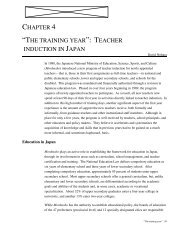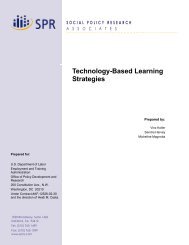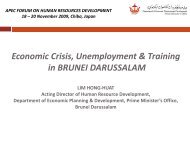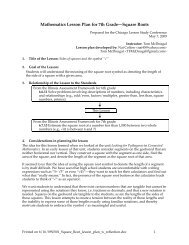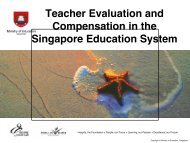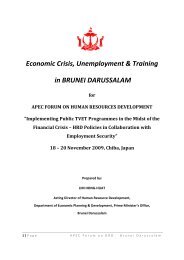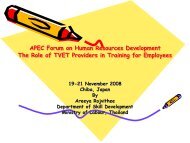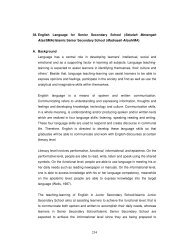Quality Assurance Systems in Asia-Pacific Economic Cooperation
Quality Assurance Systems in Asia-Pacific Economic Cooperation
Quality Assurance Systems in Asia-Pacific Economic Cooperation
Create successful ePaper yourself
Turn your PDF publications into a flip-book with our unique Google optimized e-Paper software.
ENHANCEMENT OF QUALITY ASSURANCE SYSTEMS IN HIGHER EDUCATION IN APEC MEMBER ECONOMIES<br />
3. Characteristics of the <strong>Quality</strong> <strong>Assurance</strong><br />
Framework<br />
<strong>Quality</strong> assurance has a variety of mean<strong>in</strong>gs world-wide. For the purpose of this<br />
questionnaire, an <strong>in</strong>clusive <strong>in</strong>terpretation was used. It covers the processes used by quality<br />
agencies, such as accreditation, assessment, audit and registration, and also their quality<br />
improvement and enhancement activities. Whichever processes and activities are carried out,<br />
they need to be coord<strong>in</strong>ated <strong>in</strong> a structured fashion so the agency achieves its goals. This<br />
coord<strong>in</strong>ated structure can be called a ‘quality assurance framework’, and this section<br />
describes the frameworks <strong>in</strong> the APEC economies.<br />
3.1 Size of the System and Unit of <strong>Quality</strong> <strong>Assurance</strong><br />
The size of the system to be covered by the QA process varies from a few thousand<br />
programs to only a few <strong>in</strong>stitutions. The size of the system does not seem to <strong>in</strong>fluence the<br />
choice of unit for quality assurance. For example, NZUAAU (8 <strong>in</strong>stitutions), UGC of Hong<br />
Kong (8) and MoE of S<strong>in</strong>gapore (11) have very small systems to oversee. But they primarily<br />
take the <strong>in</strong>stitution as a whole for review. (Even <strong>in</strong> the case of thematic reviews by the UGC of<br />
Hong Kong, the themes cut across the whole <strong>in</strong>stitution.) It is also important to note that <strong>in</strong> all<br />
economies there are both <strong>in</strong>stitutional- and program-related QA mechanisms <strong>in</strong> place. These<br />
responsibilities are sometimes shared by multiple agencies and at times the same agency<br />
may do both. For example, the Malaysian Qualifications Authority proposes to do both. NAA<br />
of Russia, HKCAA of Hong Kong, BDNAC of Brunei, and CNAP of Chile are a few other<br />
examples where a s<strong>in</strong>gle QA agency does both <strong>in</strong>stitutional and program review.<br />
Although the size of the education system to be covered does not seem to have a direct<br />
relationship with the choice of the unit for QA, size does <strong>in</strong>fluence other aspects of QA.<br />
Policies and practices related to participation of agency staff <strong>in</strong> site visits, selection of<br />
reviewers and constitut<strong>in</strong>g the review team, and the place given to tra<strong>in</strong><strong>in</strong>g of reviewers are<br />
shaped partly by the size of the system. For example, <strong>in</strong> large systems, there is a heavy<br />
reliance on external reviewers with limited support from the QA body. Consequently the<br />
review requires reviewers who are competent enough to adhere to the QA framework but with<br />
m<strong>in</strong>imum direct guidance from the QA staff while on the responsibility. Identify<strong>in</strong>g external<br />
reviewers may not be a big challenge <strong>in</strong> big systems but tra<strong>in</strong><strong>in</strong>g them to adhere to the quality<br />
assurance framework <strong>in</strong> a consistent manner, putt<strong>in</strong>g <strong>in</strong> place appropriate safeguards to<br />
m<strong>in</strong>imise <strong>in</strong>ter-team variances and ensur<strong>in</strong>g professionalism <strong>in</strong> such large operations may<br />
become very challeng<strong>in</strong>g. The survey <strong>in</strong>dicates that except for a couple of systems, agencies<br />
have tra<strong>in</strong><strong>in</strong>g programs and compulsory attendance <strong>in</strong> workshops for reviewers. These will be<br />
discussed later.<br />
3.2 Major Functions of QA <strong>Systems</strong><br />
<strong>Quality</strong> assurance systems of the APEC region have different objectives and functions as<br />
their priority. For some, the predom<strong>in</strong>ant objective is accountability; for others, it is quality<br />
enhancement and provid<strong>in</strong>g public <strong>in</strong>formation on quality of the <strong>in</strong>stitutions and programs; for<br />
some others the predom<strong>in</strong>ant aim is help<strong>in</strong>g <strong>in</strong> self-improvement of <strong>in</strong>stitutions. In most cases,<br />
the objective of quality assurance is a comb<strong>in</strong>ation of all of the above, but the emphasis on<br />
each varies <strong>in</strong> different economies, depend<strong>in</strong>g on the characteristics of the higher education<br />
system and the degree of accountability required by various authorities. It is important to note<br />
that quality enhancement f<strong>in</strong>ds a mention as one of the top few objectives <strong>in</strong> all the<br />
economies. Depend<strong>in</strong>g on the purpose of establishment although some have accountability<br />
as the priority agenda, quality enhancement, self improvement and provid<strong>in</strong>g <strong>in</strong>formation to<br />
public also f<strong>in</strong>d a notable mention.<br />
Next to accountability, quality enhancement, self improvement and provid<strong>in</strong>g <strong>in</strong>formation to<br />
public, the APEC economies seem to have ensur<strong>in</strong>g more ‘transparency’ <strong>in</strong> the higher<br />
education system through the QA process as one of their major functions. A couple of the QA<br />
10



